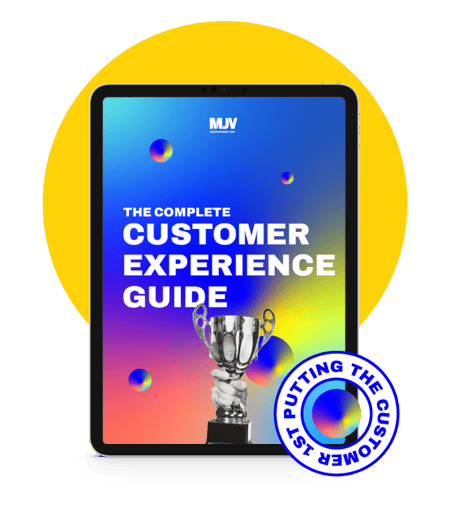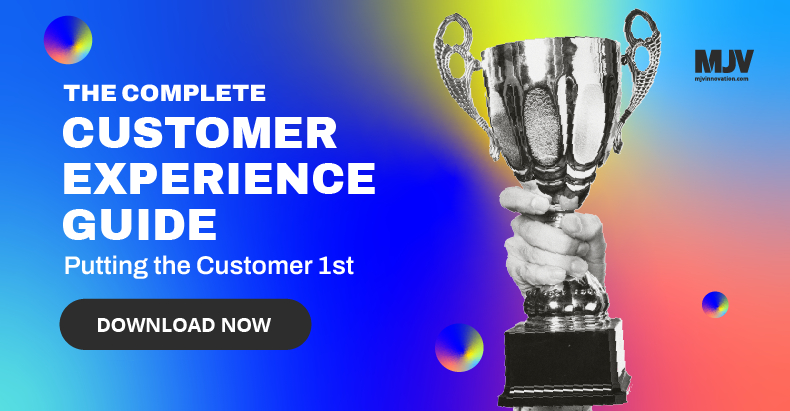7 Steps To Improve Customer Experience
Improving CX is a complex task that involves several detailed and coordinated actions. But primarily, it’s about people, whether they be clients or employees. Read our article for 7 crucial steps to improve Customer Experience
As the digital era evolves, providing top-quality CX has become increasingly complex, involving coordinated actions, detailed processes, judicious choice of channels, processing data and converting it into business insights, and much more.
Many experts offer many solutions to improve customer experience, but we say: Stay clear of the gurus who say it’s simple “it’s not!” To improve customer experience some solid practices can offer a more fluid journey, and we list 7 of them in this article.
This article is part of the ebook The Complete Customer Experience Guide: Putting Your Customer 1st. Click on the image if you want to go for a more in-depth look.
What are the key aspects of Improving CX?
- Culture
- Employee Experience
- Know Your Audience
- Personalization
- Transparency
- Feedback
- Adaptability
7 Steps to Improve Customer Experience
When interacting with customers, it’s crucial to make their satisfaction the number one priority. There are a variety of ways to achieve this goal, but a combination of the following is not a bad place to start:
1) Getting the culture right
A company’s culture refers to its values, perspectives, and goals. Every member of an organization contributes to the culture, but leaders within the company usually set the standard. When trying to put the customer first, remember that the customer is the person that allows the business to exist in the first place.
When employees notice customers are the ones keeping the business going, they’re more likely to treat them with respect.
Take Southwest Airlines, for example. The airline industry has, in the past, been tarnished for its poor customer service.
Southwest Airlines are challenging such views with their company promise, which states they will:

Southwest has been operating for 43 years and perfectly communicates its vision and mission to its employees, creating a unified team.
2. Employee experience matters
Customers can usually tell when an employee is happy, and satisfied employees lead to a more pleasant customer experience because positivity breeds positivity.
One of the ways to make consumers feel comfortable is by surrounding them with happy employees.
Zappos is an example of creating a stable work environment. The shoe retailer is recognized for its great culture that begins from the very start with a job interview that analyzes whether a person is suitable for the company environment.
One of the more staggering things Zappos offers new employees is the opportunity to receive $2,000 in exchange for quitting after the first week.
Those who stay are introduced to the organization’s ten company values. A concept based on an employee poll on what they think the company’s core values should be. Hundreds of ideas were submitted, which resulted in foundational themes.

When a good work culture is in place, customer satisfaction comes hand-in-hand with building a good brand.
3) Targeting Your Audience
Putting the customer first is easier when you know who your customers are. Targeting the audience allows for the creation of a typical customer profile. Knowing your customers’ age, interests, and schedules enables you to create an experience that feels custom-fitted for them.
Take Amazon, for example, and their use of Personalization for Better Convenience.

Recommended products are based on purchase history and views, and this algorithm offers value to Amazon while making shopping more convenient for customers. The convenience attained through personalization helps to attract new customers while retaining existing ones.
4. Personalize the customer experience
Consumers want to feel special by receiving a personalized experience. Creating minor customizations that make customers feel they are being noticed can make a big difference. It can be simple gestures, such as writing a thank you note after serving them, knowing their usual order, or remembering their name. Small gestures can go a long way in improving CX.
Customers notice when an employee goes beyond the norm of duty to offer assistance.
Take, for example, Trader Joe’s. The privately-owned grocery chain that always looks to prioritize customers.
One of their more famous stories about customer attention surrounded an 89-year-old man who was snowed in at his Pennsylvania home around the holidays. His daughter was concerned about getting him food and called a bunch of stores to see if anyone had delivered.
Trader Joe’s went against their own policy to deliver the items that fit his low-sodium diet for free.
When organizations put in the extra effort with a customer, even when it’s not required, customers will notice and appreciate you. Again, customers who receive this high level of care are likely to return more frequently.
Content you also might like
→ Hiper-Personalization: The Next Level of Customer Service
5. Transparency
It’s simply impossible to satisfy customers 100% of the time, but the best approach is always to be transparent with them; most customers will appreciate honesty. Letting unsatisfied customers know what is stopping you from fully meeting their needs can help mitigate negative reactions.
Even if you’re unable to satisfy a customer completely, in general, consumers are less frustrated when they are told the truth about your situation.
If you are looking for a quality example of solid transparency, look no further than the outdoor clothing brand Patagonia, which looks to build trust through transparency.
Patagonia has aligned itself with environmentally-friendly goals for decades. You can see this in their mission statement, which highlights the importance of the initiative to them and which sits well with their customers, who are often young adults interested in sustainability.

They openly list where their apparel is produced and have a Supplier Code of Conduct that is strictly enforced online. Patagonia is also more than willing to answer questions about the sourcing of its products and is honest about its shortcomings.
This upfront honesty helps soothe the concerns of skeptics and ultimately builds confidence that Patagonia truly believes in its mission statement.
6. Ask for Feedback
When trying to figure out the best way to enhance customer experience, the easiest way is often to simply ask – not exactly what they want, but what they think about your offer.
Most customers are willing to give insight into what they want out of business. Through simple questions like, “Is there anything else I can help you with?” customers can explain what it takes to make them feel special.
You can say what you like about the nutritional quality of their burgers, but you can’t accuse McDonald’s of not listening to their customers.
Through looking at different ways of capturing customer feedback, including social media and online surveys, McDonald’s has done its best to identify what customers want from the fast food chain.
For example, it discovered a desire for healthier menu options and longer opening hours. Similarly, McDonald’s acted on the customer’s desire for breakfast items throughout the day,
introducing its ‘All Day Breakfast’ in select US stores. It based this strategy on data sourced from its social listening efforts.
Content you also might like
→ Jobs To Be Done: How to Properly Listen To Your Customers
7. Being adaptable and willing to adjust
When we think about customer-centricity, we can’t lose sight of buyer journeys – contemporary digital demands from consumers to offer multiple journey options and touchpoints for conversion. More touchpoints can mean more opportunities.
Those journeys are meticulously planned (or should be) – and this doesn’t happen without iteration, which means going back and forth through the processes to identify friction points and fix them. Evidence shows that adapting services to meet customers’ needs; keeps them returning.
When it comes to adaptability, the example of Kodak comes to mind. Kodak used to dominate the photography industry. However, its failure to respond fast enough to the advent of digital photography saw the company file for bankruptcy in 2013.
But they have since bounced back and risen from the dead.

Aimed at photographers, KodakCoin forms part of a broader blockchain platform committed to protecting photographers and helping them control their image rights. Kodak has returned to prominence by adopting a proactive approach to new technology.
Have we got it right? Learn more about not to improve Customer Experience
Need help understanding your consumer? Perhaps one option is to not listen to them! Yep, you read that right, well, sort of; let us explain:
Henry Ford once said:
“If i had asked people what they wanted, they would have said faster horses.”
His point was that if you listen to your customers’ demands directly, they will tell you what they THINK they need. But they rarely know what is actually going to solve their problems, which in Henry’s case, was cars instead of horses.
Instead, we suggest that you:
1) Focus less on your solution and more on how it solves problems. Its context of use.
2) Get your insights from customer behavior, not only from what they’re telling you. Try to identify the subtext behind what they’re saying.
Delivering the best experience to your consumer doesn’t have to be overly complicated. But how to get started? You just need the right method & strategy, right?
Ready to improve your company’s customer experience? Want to learn more about how to better understand your customers?
Then give our Customer Experience Guide a go; pick up your free copy here:
Back

